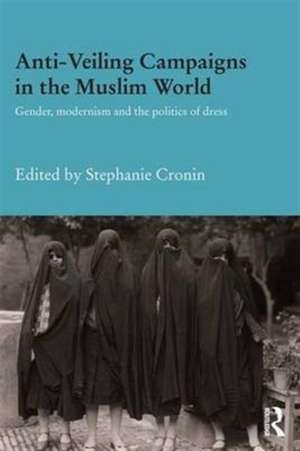Anti-Veiling Campaigns in the Muslim World: Gender, Modernism and the Politics of Dress: Durham Modern Middle East and Islamic World Series
Editat de Stephanie Croninen Limba Engleză Paperback – 24 apr 2016
| Toate formatele și edițiile | Preț | Express |
|---|---|---|
| Paperback (1) | 414.32 lei 6-8 săpt. | |
| Taylor & Francis – 24 apr 2016 | 414.32 lei 6-8 săpt. | |
| Hardback (1) | 1172.23 lei 6-8 săpt. | |
| Taylor & Francis – 22 apr 2014 | 1172.23 lei 6-8 săpt. |
Din seria Durham Modern Middle East and Islamic World Series
- 8%
 Preț: 389.14 lei
Preț: 389.14 lei -
 Preț: 325.50 lei
Preț: 325.50 lei - 18%
 Preț: 1217.29 lei
Preț: 1217.29 lei -
 Preț: 415.67 lei
Preț: 415.67 lei - 18%
 Preț: 1054.75 lei
Preț: 1054.75 lei -
 Preț: 383.63 lei
Preț: 383.63 lei -
 Preț: 448.12 lei
Preț: 448.12 lei -
 Preț: 415.09 lei
Preț: 415.09 lei -
 Preț: 385.54 lei
Preț: 385.54 lei -
 Preț: 460.69 lei
Preț: 460.69 lei - 24%
 Preț: 322.48 lei
Preț: 322.48 lei - 28%
 Preț: 848.55 lei
Preț: 848.55 lei -
 Preț: 486.21 lei
Preț: 486.21 lei -
 Preț: 484.22 lei
Preț: 484.22 lei - 25%
 Preț: 823.63 lei
Preț: 823.63 lei - 18%
 Preț: 1166.80 lei
Preț: 1166.80 lei - 18%
 Preț: 1226.34 lei
Preț: 1226.34 lei -
 Preț: 387.49 lei
Preț: 387.49 lei -
 Preț: 407.40 lei
Preț: 407.40 lei -
 Preț: 462.60 lei
Preț: 462.60 lei -
 Preț: 395.21 lei
Preț: 395.21 lei -
 Preț: 489.30 lei
Preț: 489.30 lei - 18%
 Preț: 1058.43 lei
Preț: 1058.43 lei - 18%
 Preț: 1165.97 lei
Preț: 1165.97 lei - 18%
 Preț: 1056.32 lei
Preț: 1056.32 lei -
 Preț: 438.14 lei
Preț: 438.14 lei - 18%
 Preț: 1063.31 lei
Preț: 1063.31 lei -
 Preț: 419.32 lei
Preț: 419.32 lei - 18%
 Preț: 1217.29 lei
Preț: 1217.29 lei -
 Preț: 461.50 lei
Preț: 461.50 lei - 18%
 Preț: 1162.84 lei
Preț: 1162.84 lei - 18%
 Preț: 1054.97 lei
Preț: 1054.97 lei - 18%
 Preț: 1222.82 lei
Preț: 1222.82 lei - 18%
 Preț: 1062.98 lei
Preț: 1062.98 lei - 28%
 Preț: 848.55 lei
Preț: 848.55 lei -
 Preț: 488.29 lei
Preț: 488.29 lei - 18%
 Preț: 1114.98 lei
Preț: 1114.98 lei
Preț: 414.32 lei
Nou
Puncte Express: 621
Preț estimativ în valută:
79.28€ • 83.05$ • 65.71£
79.28€ • 83.05$ • 65.71£
Carte tipărită la comandă
Livrare economică 08-22 aprilie
Preluare comenzi: 021 569.72.76
Specificații
ISBN-13: 9781138687202
ISBN-10: 1138687200
Pagini: 304
Ilustrații: 24
Dimensiuni: 156 x 234 mm
Greutate: 0.41 kg
Ediția:1
Editura: Taylor & Francis
Colecția Routledge
Seria Durham Modern Middle East and Islamic World Series
Locul publicării:Oxford, United Kingdom
ISBN-10: 1138687200
Pagini: 304
Ilustrații: 24
Dimensiuni: 156 x 234 mm
Greutate: 0.41 kg
Ediția:1
Editura: Taylor & Francis
Colecția Routledge
Seria Durham Modern Middle East and Islamic World Series
Locul publicării:Oxford, United Kingdom
Public țintă
Postgraduate and UndergraduateCuprins
Introduction: Coercion or Empowerment? Anti-Veiling Campaigns: A Comparative Perspective Part 1: Turkey 1. From Face Veil to Cloche Hat: The Backward Ottoman versus New Turkish Woman in Urban Public Discourse 2. Anti-Veiling Campaigns and Local Elites in Turkey of the 1930s: A View from the Periphery 3. Everyday Resistance to Unveiling and Flexible Secularism in Early Republican Turkey Part 2: Iran and Afghanistan 4. Unveiling Ambiguities: Revisiting 1930s Iran’s Kashf-i Hijab Campaign 5. Dressing Up (or Down): Veils, Hats, and Consumer Fashions in Interwar Iran 6. Astrakhan, Borqa’, Chadari, Dreshi: The Economy of Dress in Early 20th Century Afghanistan Part 3: Soviet Central Asia and the Caucasus 7. Women-Initiated Unveiling: State-led Campaigns in Uzbekistan and Azerbaijan Part 4: The Balkans 8. Behind the Veil: The Reform of Islam in Inter-War Albania or the Search for a ‘Modern’ and ‘European’ Islam 9. Difference Unveiled: Bulgarian National Imperatives and the Re-Dressing of Muslim Women, 1878-1989
Recenzii
"The book’s most obvious common theme is the correspondence between the need to carve put a national character and the female body politic. Anti-veiling in these countries was an opposition to Arabisation; the veild came to be seen as a cultural import that was both alien and foreign in the modernising State. By comparison, even at the height of secular nationalism in the Arab world, Stephanie Cronin notes that there were no official attempts to change "sartorial practices in any systematic way". The second theme that is pertinent throughout the book is the way in which suppositions about female dress can be contradictory. Face veils, cast as backward and submissive, wee in fact widely accepted and practised by elites in these countries prior to forceful unveiling reforms enacted during the 20th century".
R.Khan , The Royal Society of Asian Affairs
R.Khan , The Royal Society of Asian Affairs
Descriere
The controversy about the veiling of women, particularly pronounced in recent times, and the deeper issues it represents are not new. This book examines the state-sponsored anti-veiling campaigns which took place across wide swathes of the Muslim world in the interwar period. It shows how veiling was officially discouraged and frequently ridiculed as backward, but how the anti-veiling campaigns were flawed, mostly promoted by male dominated authoritarian regimes, which, in politicising the issue, empowered opponents who used veiling as a symbol of resistance. Throughout, the book relates the significance of interwar unveiling campaigns to present day debates.














